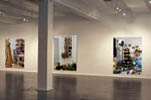 |
|
‘There is something uneasy’
Text written for SPACE at the Triangle London 2003
There is something distinctly uneasy about this recent group of photoworks by Paul Eachus. This sense of ' not quite rightness ', of something failing to meet our expectations, ( for we live in a time of things fulfilling our expectations as exampled by mainstream Hollywood blockbuster movies) pervades these works on every level from the photoworks content through to the relationship with the medium of photography itself. These works are clearly not about photography they resist the familiar notion of re-presenting the world through the information contained within the frame. What is presented to us within the rectangular vertical format is incomplete, there is always more happening outside the frame, as if the camera fails to exert its power and control over events. A slippage occurs, something at the very limit of the edge, its boundary, suggests more is happening beyond this point, out of sight. Perhaps that which is going on in front of our eyes is the result of this something outside the boundary. The conditions for what we see are determined elsewhere. We are left with the idea that these images are in fact details, but details leave us knowing even less about the whole suggesting that there is a fallacy in the relations between parts and wholes, as Maurice Blanchot remarks '....... the fragment, while it never is unique, still it has no external limit - the outside toward which it falls is not its edge '. 1
The photograph as detail then implies concepts of scale, from the small outwards to the large, yet here we begin with the large, the works being towards human scale, giving them a physical presence as objects within an architectural space. There is a contradiction at work between the works implication in terms of representation and depiction and what it might propose as a detail. There is the suggestion as asserted by the artist/curator Antonio Ortega that what simmers beneath this work is an uneasiness with the medium of photography, a critical meditation upon the hegemonic nature of photography coupled with the recognition of the impossibility of communication. This impossibility of communication has its roots within an existentialist view of the world on the one hand and on the other with the inadequacy of language emerging out of the awareness of the necessity of language but ultimately in its inadequacy, its failure. For it is when we are in language that we experience our separation from it. Similarly in these photoworks Eachus presents us with a question - 'what kind of photograph are we confronted with' ?. Their initial appearance suggests the kind of photo image familiar to us in glossy magazines, furniture and designer office equipment catalogues, think of Habitat, IKEA or Conran. The lighting is direct and used to depict rather than create ambience or as a means of nuancing the subject. We are confronted by something we recognise as an installation or as the artist prefers to think of it as a display or arrangement; somehow the term 'installation' is now so loaded, historicized and embraced by mainstream art criticism. This display places the photograph into one of its traditional roles as documentary evidence, as it where as secondary to the real thing But these displays do not exist outside of the photowork, in fact the roles become reversed, the photowork becomes the 'real thing' which in turn adds another element to the experiencing of something being 'not quite right' that of separation and distancing a further reflection on the existential. In viewing these photoworks there is an overwhelming sense of an absence of a centre, a place to start from or a central element that allows us into the fictive space of the work. There is no centre, but many centres, many starting points that suggest beginnings, middles and conclusions but these all exist within the one work as if we are witnessing multiple narrative events all of which are at differing points of their individual unfolding processes. There is a Borgesian referencing here whereby time is folded back on itself, the familiar linearity of time is replaced in favour of a multiplicity of kinds of time. each of these fictive events are going on seemingly unaware of each other, separately evolving, being in process, being caught momentarily like time lapse photography but operating at different speeds. Yet an added complexity is the context in which these events are happening; we anxiously search for something to ground these events - there might be the safety of the context which holds and rationalises things, as with site specific work or that is made directly in response to particular contexts. But in these works the context adds little or nothing to the events played out before us, bland walls and floors vaguely suggestive of a gallery, office or contemporary domestic space, but also the possibility of a photographic set, a temporary structure devised to satisfy the rectangular frame of the camera, suggesting as with TV and film sets that were the camera to pull back we would instantly have revealed to us the temporary and illusory nature of what we see. These works then seem to operate on different levels of conceptual, political and formal awareness, they disrupt and avoid the familiar tropes of art making whilst maintaining the appearance of such tropes; on serious engagement these fall away acting as lures seducing the viewer into the work which having fulfilled their role leave the viewer adrift, uncertain in a space of things being ' not quite right'.
Daniel Geyers
Berlin 2002
|